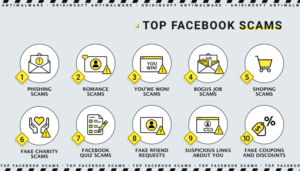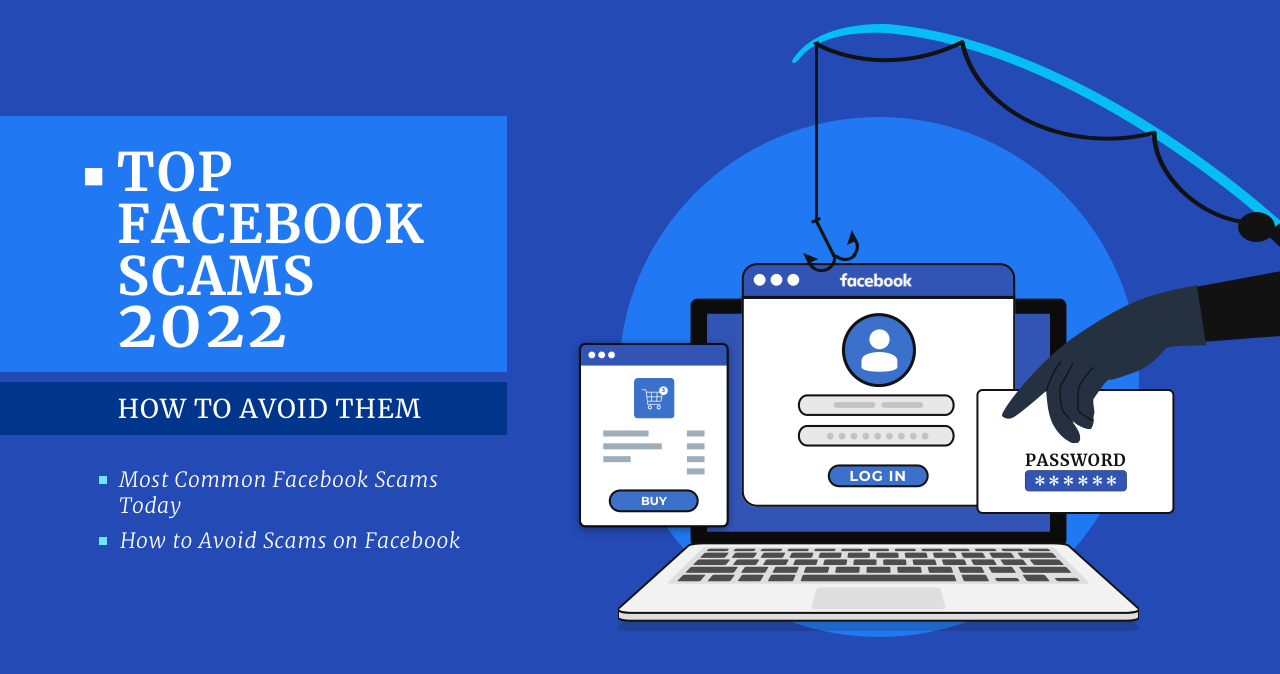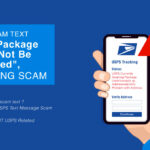More than 2.8 billion people log in to Facebook monthly to connect with friends, share information, get their news, and even shop. The world’s most popular social media platform is Facebook. The site has so many active users that scammers have a huge potential pool of victims to try their tricks on. If only a tiny part of those people get scammed, that is still a massive win for the scammer. Unfortunately, the site’s popularity makes it vulnerable to cybercriminals.
According to the U.S. Federal Trade Commission, hundreds of millions of dollars are lost annually due to social media scams. Knowing the most common scams and taking the appropriate steps to avoid them is how you can prevent them on Facebook.

Most Common Facebook Scams Today
Fraudsters develop new ways and methods to make an attack and remain unseen. Such threats are often the users’ login credentials and financial data. Here is a list of the most common Facebook attacks on the social network.
Phishing Scams, Facebook Email Scams
Facebook Phishing emails are increasingly used in Facebook fraudulent attacks, and Facebook users are exposed to such attacks as well. Such letters will include a link and wording that tells you to go to Facebook. The link will take you to a website that looks like Facebook but is fake. Sometimes, websites will tell you that you’ve gotten your account hacked. Other times, they will ask you to verify your login information. There are many of the most dangerous types of phishing attacks that are carried out using various technologies.
One way that sites are trying to get you now is to email you a link to reset your Facebook account, saying that it has been shut down for security reasons. Cybercriminals want you to give them private information using fake websites or apps. The reason can be anything, but their goal is always the same. When you fall for a phishing scam, criminals have all the information they need to mess up your social media account.
Shopping Facebook Scams
Facebook is a platform where many companies and organizations work; they put their data and do business. Most organizations promote their products there and look for potential customers through various advertising posts, messages, and others. This is another one of the great examples of Facebook attacks to watch out for! Fraudsters, in this case, are no exception; they can also attract the audience to buy a particular product. As a result, the user can believe the banner and pay for the offered thing but never get it.
Bogus Job Facebook Scams
Announcing good online work is always tempting. But it should be understood that such offers can be fake and do not carry profound implications. So before agreeing to such an offer, ensure the legitimacy of the organization that makes such an announcement. Because if you take this job, the first thing you’ll be asked about is your address, your insurance number, a copy of the paperwork, and other important data. In this case, you risk compromising your privacy.
Charity Scams
Fraudsters always try to influence the user’s emotional state. The charity case is no exception. Scammers create fake charity profiles that post photos of outsiders who need immediate help and make money from donations. On this basis, be careful before you make a transaction; explore the organization that does this. Helping the sick or the elderly is good, but address the money to the ones who need it.
How to Avoid Facebook Scams
Below, we will guide you to protect yourself from Facebook fraud. With these tips, you can reduce the risk of fraudulent threats to you and your data.
1. Lock down your Facebook privacy settings
Make sure your privacy is well protected. For example, you can hide pictures and videos from third-party users who are not your friends. To do so, make the following changes in Settings:
- Launch the Facebook app.
- In the upper right corner of the screen, tap on the down arrow (on iPhone) or hamburger menu (on Android).
- Select Settings & Privacy from the menu.
- On iPhone, choose Privacy Checkup. On Android, tap Settings to open another page where Privacy Checkup is. After that, Facebook will walk you through the most common privacy settings and recommend each option.
2. Enable two-factor authentication
Two-factor authentication is a good way to log in to your account more securely. It supposes you should enter the one-time code you receive on your phone number, aside from your login and password, when logging in. You will receive this code as a text message or through the application. To do this, follow the instructions below:
- Launch Facebook on your computer or app.
- In the upper right corner of the screen, tap on the down arrow.
- Select Settings & Privacy > Settings > Security & Login.
- At the bottom of the page, find the Two-Factor Authentication and tap Edit.
3. Decline a friend request from anyone you don’t know
Please take it as a habit not to accept all requests as friends. You don’t need extra friends if you are not blogging or interested in publicity. Communicate only with those you know. It’s an excellent way to protect yourself from many phishing attempts.
4. Ignore messages asking for personal information or money
If you have received a letter asking for financial assistance from a stranger, it is better to ignore this. If this character is on your friend list, then better call him and find out if he needs it. Such requests via Facebook are more of a scam than a serious request for help.
5. Don’t click on suspicious links
Avoid clicking on links or attachments no matter what message you receive. Open them only if you know for sure that these are messages from the user you really know. If you do not know how to verify the legitimacy of the sender, then follow these instructions:
- Launch Facebook on your computer or app.
- In the upper right corner of the screen, tap on the down arrow.
- Select Settings & Privacy > Settings > Security & Login.
- At the bottom of the page, find Advanced and tap Recent Emails from Facebook.
6. Check your login history regularly
Keep an eye on where your account is logged in from. This will help you to detect and remove unwanted sessions. It may also be an indicator of compromised account security.
- Launch Facebook on your computer or app.
- In the upper right corner of the screen, tap on the down arrow.
- Select Settings & Privacy > Settings > Security & Login.
- At the bottom of the page, find Where You’re Logged In and review it for accuracy. Delete any suspicious logins.
7. Use a strong password
Using the same password for several accounts is undesirable. Therefore, create a strong and unique password that will not be easy to decrypt. To do this, use combinations with different letters and characters. The most specific passwords are easiest to crack with various password dictionaries and brute force tools.
8. Search regularly for accounts in your name
At that moment, too, you should remember and look for profiles with such a name on the network from time to time. Because fraudsters often use cloning accounts to appear like legitimate users. If you find such a counterpart, inform Facebook support about such a profile. To do this, tap on the three dots on a person’s profile and choose to Find Support or Report Profile. That is especially important when you are a public person, and someone may be interested in stealing your identity.






I purchased boots from Clarks online through Facebook. This was terrible they won’t return my money the product I don’t like and won’t fit. They are very unprofessional.